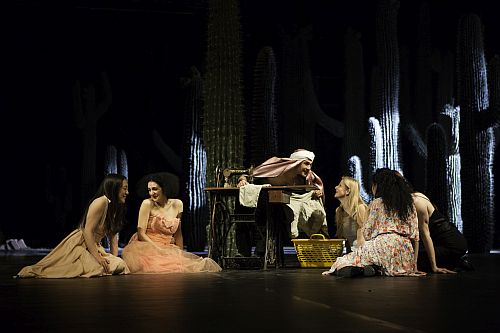 United Kingdom Monteverdi, Dowland, Traditional,Jazz, Ahnen: Tanztheater Wuppertal Pina Bausch, Sadler’s Wells, London, 23.4.2013 (J.O’D)
United Kingdom Monteverdi, Dowland, Traditional,Jazz, Ahnen: Tanztheater Wuppertal Pina Bausch, Sadler’s Wells, London, 23.4.2013 (J.O’D)
Dancers: Pablo Aran Gimeno, Andrey Berezin, Matthias Burkert, Aleš Čuček, Lutz Förster, Ditta Miranda Jasfi, Scott Jennings, Barbara Kaufmann, Nayoung Kim, Daphnis Kokkinos, Dominique Mercy, Cristiana Morganti, Nazareth Panadero, Helena Pikon, Jean Laurent Sasportes, Franko Schmidt, Azusa Seyama, Julie Shanahan, Julie Anne Stanzak, Michael Strecker, Fernando Suels Mendoza, Aida Vainieri, Anna Wehsarg, Paul White, Tsai-Chin Yu
Production:
Saxophonist: Niall Webb
Choreographer: Pina Bausch
Set Design: Peter Pabst
Costume Design: Marion Cito
Collaboration: Hans Pop
Musical Collaboration: Matthias Burkert
Dramatic Advisor: Raimund Hoghe
Music: Claudio Monteverdi, John Dowland, Songs and instrumental music from the Middle Ages and the Renaissance, traditional music from the Nubians, Hamar, Senufo, Folk music from Switzerland, Italy, Spain and the Caribbean, early Jewish instrumental music, Rock and Pop music from Japan, music from the twenties and thirties with Fred Astaire, Ella Fitzgerald and Billie Holiday.
‘It was in the period where Pina was interested in reducing dance,’ says set designer Peter Pabst, in the programme note about Ahnen. Pina Bausch created this work in 1987, three years after Auf dem Gebirge hat man ein Geschrei gehört (which was performed at Sadler’s Wells a week ago). The stage in the earlier production may have been covered in earth, but it was uncluttered earth. The stage for Ahnen is full of very large cacti. These take up space and obscure the view. They make it possible only to focus comfortably on what happens downstage. They make it difficult to see, among other things, the wall of bricks that one of the female dancers is intermittently constructing at the back.
The audience is kept at a distance, too, by the rapid-fire introduction of so many uncanny and briefly seen figures. The mid-twentieth-century fashions of Auf dem Gebirge (the ballgowns, the tailored ‘costumes’, the men’s suits, the women’s heeled shoes) have been extended to include a ‘punk’ in sunglasses, leather jacket and kilt who acts initially as a kind of host. It is not until some way in to the piece that a woman whose face is outlined in red with the shape of a heart, settles down on a chair at the front of the stage to begin a seemingly inexplicable, repeated action as she casts an eye over the audience. The action in this case is to rub something that resembles a block of chalk across a board, sometimes across her bare knee, while keeping a lighted candle in a glass cover tucked between her crossed legs.
A range of similarly repeated actions follows. Between their significant entrances and exits, the dancer/performers of Tanztheater Wuppertal Pina Bausch make these actions engaging enough to invite interpretation, intriguing enough to resist it. You can use up quite a lot of intellectual energy trying to work out the relevance of the elegant but troubled-looking woman in sunglasses who spends most of the piece, and all of the interval, seated at a table to one side of the stage as if slowly taking breakfast in an expensive hotel. You can ask yourself why three men are rubbing breadcrumbs over the arms and legs of another woman who lets a fistful of sand flow from one hand to the other while they do so.
Translated as a noun (in the Wichmann’s German Dictionary), ‘Ahnen’ means ‘ancestors’ or ‘forefathers’; as a verb it means ‘to have a presentiment’. Perhaps the piece looks in both a backward and a forward direction. It uses music from the Renaissance, from nineteenth-century opera, and from the 1930s. There is a reference to Shakespeare’s Ophelia. But one of the funniest, or saddest, moments is when a man checks his diary with the audience. As he goes through the days, the weeks, the months, the years, we come to realize that except for lunch with an aunt on Christmas Day he is free indefinitely.
There was the occasional false note (a reference to Marks & Spencer, a reference to Twinings tea) – and a problem with a lowered safety curtain that refused to rise which meant that the performance came to a halt shortly before the end. After a twenty minute interval, the dancers had only ten minutes or so to re-establish the atmosphere. For the way they did this and for what they had given of themselves through their bodies and their voices over the course of the piece, they received a standing ovation.
John O’Dwyer

